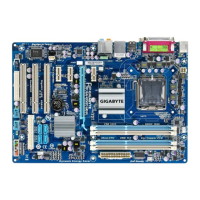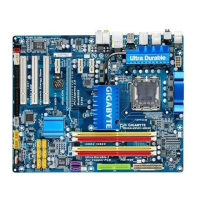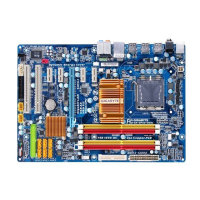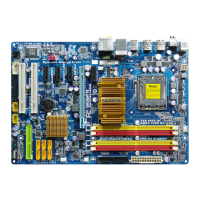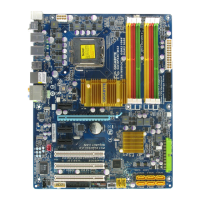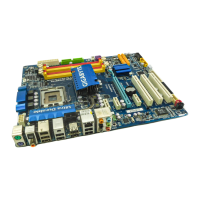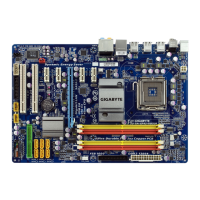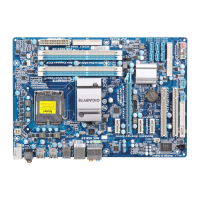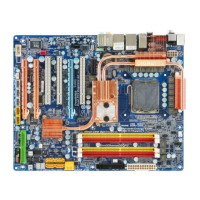Do you have a question about the Gigabyte GA-EP41-UD3L and is the answer not in the manual?
How to identify the specific revision of your motherboard.
List of items included in the motherboard package.
List of additional accessories that can be purchased.
Diagram showing the physical layout of motherboard components.
Schematic representation of the motherboard's architecture and connections.
Essential safety guidelines before installing hardware.
Detailed technical specifications of the motherboard.
Step-by-step guide for CPU and cooler installation.
Instructions for installing RAM modules.
Guide for installing PCI or PCIe cards.
Identification and function of rear I/O ports.
Identification of motherboard internal headers and connectors.
Overview of boot screens and function keys.
Navigation and function keys within the BIOS Setup.
Advanced CPU and memory performance tuning options.
System date, time, and basic hardware configuration.
Configuration of advanced system settings and security.
Enabling/disabling onboard devices like SATA, LAN, Audio.
Configuring system power saving states and wake-up features.
Managing Plug and Play and PCI resource assignments.
Monitoring system temperatures, voltages, and fan speeds.
Restoring stable, safe default BIOS settings.
Restoring optimal performance default BIOS settings.
Setting BIOS access passwords for security.
Saving BIOS changes and exiting the setup utility.
Discarding BIOS changes and exiting the setup utility.
Installing essential chipset drivers for system functionality.
Installing GIGABYTE utilities and bundled software.
Accessing application guides and motherboard manuals.
GIGABYTE contact information and website links.
Viewing basic system information.
Linking to GIGABYTE website for latest downloads.
Utility for system data backup and restoration.
Tools for updating the system BIOS (Q-Flash, @BIOS).
Windows utility for system tuning and overclocking.
Software for optimizing power saving and efficiency.
Tool for sharing data over a network.
System backup and restore based on Volume Shadow Copy Services.
Setting up motherboard audio jacks for input/output.
Setting up digital audio input and output connections.
Steps for setting up and using the microphone.
How to record and play audio using the Sound Recorder tool.
FAQs and procedures to resolve common system issues.
Compliance information and environmental directives.
How to identify the specific revision of your motherboard.
List of items included in the motherboard package.
List of additional accessories that can be purchased.
Diagram showing the physical layout of motherboard components.
Schematic representation of the motherboard's architecture and connections.
Essential safety guidelines before installing hardware.
Detailed technical specifications of the motherboard.
Step-by-step guide for CPU and cooler installation.
Instructions for installing RAM modules.
Guide for installing PCI or PCIe cards.
Identification and function of rear I/O ports.
Identification of motherboard internal headers and connectors.
Overview of boot screens and function keys.
Navigation and function keys within the BIOS Setup.
Advanced CPU and memory performance tuning options.
System date, time, and basic hardware configuration.
Configuration of advanced system settings and security.
Enabling/disabling onboard devices like SATA, LAN, Audio.
Configuring system power saving states and wake-up features.
Managing Plug and Play and PCI resource assignments.
Monitoring system temperatures, voltages, and fan speeds.
Restoring stable, safe default BIOS settings.
Restoring optimal performance default BIOS settings.
Setting BIOS access passwords for security.
Saving BIOS changes and exiting the setup utility.
Discarding BIOS changes and exiting the setup utility.
Installing essential chipset drivers for system functionality.
Installing GIGABYTE utilities and bundled software.
Accessing application guides and motherboard manuals.
GIGABYTE contact information and website links.
Viewing basic system information.
Linking to GIGABYTE website for latest downloads.
Utility for system data backup and restoration.
Tools for updating the system BIOS (Q-Flash, @BIOS).
Windows utility for system tuning and overclocking.
Software for optimizing power saving and efficiency.
Tool for sharing data over a network.
System backup and restore based on Volume Shadow Copy Services.
Setting up motherboard audio jacks for input/output.
Setting up digital audio input and output connections.
Steps for setting up and using the microphone.
How to record and play audio using the Sound Recorder tool.
FAQs and procedures to resolve common system issues.
Compliance information and environmental directives.
| Number of memory slots | 4 |
|---|---|
| Maximum internal memory | 8 GB |
| Processor socket | LGA 775 (Socket T) |
| Processor manufacturer | Intel |
| USB 2.0 connectors | 2 |
| Power fan connector | Yes |
| Number of Parallel ATA connectors | 1 |
| Controller interface type | SATA |
| Controller 2nd interface type | IDE |
| Headphone outputs | 6 |
| USB 2.0 ports quantity | USB 2.0 ports have a data transmission speed of 480 Mbps, and are backwards compatible with USB 1.1 ports. You can connect all kinds of peripheral devices to them. |
| Firewire (IEEE 1394) ports | 0 |
| Audio output channels | 7.1 channels |
| Motherboard form factor | ATX |
| PCI Express x1 slots | 3 |
| LAN controller | Realtek RTL8111C |
| Networking features | Gigabit Ethernet |
| Depth | 210 mm |
|---|---|
| Width | 305 mm |
